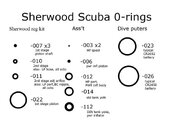Belzelbub
Contributor
Yes, it is quite a bit more popular here. And I don't have a good reason for it other than what was posted. Yoke predates DIN, and people are somewhat resistant to change.In the American market it seems that YOKE is much more popular but I cannot find one simple reason...
Can you guys explain why you chose it? Is it because you learned to dive with it, was suggested by your buddies, dive store? Is it because you cannot find tanks with a donut insert?
My first regulator and cylinder(s) were yoke only. They were purchased toward the end of the previous century. I chose yoke at that time because I'd never even heard of DIN.
Several years later, I learned about DIN, and heard good things about it. I bought a new reg in the early 2000s and got it in DIN configuration. I dove with it for several years using my original cylinders and a DIN to Yoke adapter. Even later, I got some additional cylinders and got combo valves with them. Since then, I've converted the original cylinders to DIN valves. My daughters' regs are all DIN.
A lot of newer cylinders I see today are actually combo valves, not just yoke. Yet, DIN regulators are still somewhat rare. A lot of divers may not even realize that their yoke valve has an insert that can be moved. That may mean that it might be a bit difficult to remove that insert when needed.
The way I see it, I don't see a downside to using DIN regulators. They work just fine on yoke, DIN, or combo valves. The DIN to Yoke adapter doesn't cause me any problems with my regulators, though with some regulators that protrude more from the valve, the added depth of the adapter can mean contact with the head is more likely.




